Chapter 3. Seriously Cool Places: The Future of Learning-Centered Built Environments
"Whoa, dude, this is a seriously cool place!" With that remark we knew we were on to something special. But what? The comment came from a young man upon his entry into the Studio, a prototype learning environment embedded within the newly opened Ryan C. Harris Learning Teaching Center (LTC) at the University of Dayton in Ohio. While the United States has numerous learning centers, many were created to help faculty teach with technology. The University of Dayton's LTC is different; it combines several functions traditionally disconnected and scattered throughout campus in order to promote collaboration or "to practice what we preach." Offices placed in close proximity surround communal spaces to encourage collaboration. The Studio, a café called the Blend, and large furniture-filled pathways provide opportunities to gather, discuss, and continue learning.
Many important lessons came from simple observation of the daily occurrences at the LTC. Faculty and students seemed to act differently in the Studio. They exhibited a new freedom to be creative and more actively engaged and to continue the learning process as activities flowed into other parts of the complex. These observations, many of them serendipitous, allowed new insight into the attributes of flexible, fluid space. The Studio provided opportunities to discover concepts of educational connections and links later used to develop learning space prototypes in a new residence hall.
The provost's office, in its continuing quest for academic excellence, quickly recognized an opportunity to continue its exploration of prototype spaces. The second floor of a new residence hall was set aside for additional classrooms. It became a test bed for an educational model involving intense student-faculty interaction, interdisciplinary teaching, and redefined "seat time." A new space model combined the studio concept with other teaming, seminar, and assembly areas. Pathways—spaces that normally function as hallways—were expanded to support continued learning opportunities, promote impromptu gatherings, and provide individual places for quiet reflection (see Figure 1). Faculty offices immersed in the complex encourage further interaction. The entire complex serves as a model for engagement and interaction, team teaching, and interdisciplinary themes. The assessment now under way is providing valuable information linking learning and the built environment.
Figure 1. Example of a Collaboration-Friendly Pathway
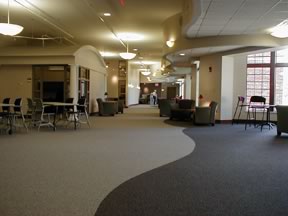
The first user of the Marianist Hall Learning Space was an innovative interdisciplinary program at the University of Dayton called Core. First-year students take two tightly integrated courses in a 12-credit-hour sequence that integrates history, philosophy, and religious studies chronologically and thematically along with selections from literature and the visual and performing arts. English composition uses materials from all of the disciplines in honing the students' writing skills.
Second-year students choose one of three social science courses and one course in either philosophy or religious studies. They also take one arts studies course. These three courses build on what the students learned in the first-year courses, focusing on contemporary issues.
We are learning that space, properly conceived and built, is essential to learning. Just how is the Marianist Hall Learning Space used? A story told through a user's eyes might give some insight into just how students and faculty interact.
Marcy
"Ummmff." Marcy groaned and hit the snooze button one more time. She then pulled the pillow over her head and wished she were home. Finally, she roused herself, reluctantly slipped into her bunny slippers, and pulled on a warm University of Dayton sweatshirt. After a quick brush of hair and teeth, and with eyes only half open, she made her way to the small café in her residence hall, clutching a notebook and laptop computer.
"Hey, Sam…Hey, Carol." She worked her way past new friends and grabbed some much needed caffeine. Marcy made a slight face at the first sip. "Not Starbuck's, but okay." She trudged up the steps, laptop and notebook balanced with her coffee cup and bunny slippers flopping, to begin her first day in Core.
She paused at the top of the stairs and glanced at a small greeting sign, Welcome to Marianist Hall Learning Space. Then she looked ahead and realized this was something different. No tight and congested hallways. No classrooms lined up like a series of bland boxes and crammed with tablet arm chairs. She blinked and tried to understand what she was supposed to do. The complex stretched ahead with pockets of intriguing spaces running off this direction and that—leading to where? she wondered. Her eye followed the sinuous curve of the ceiling to a far point that ended in a deep-brown wall. Comfortable looking chairs and sofas grouped around coffee tables invited her to sit for a while with her steaming coffee. The small table lamps cast a welcoming glow, more homelike than institutional. "I'll need to come here to study," she thought, making a mental note of the tables available to spread out books and the access to wireless. Marker boards were everywhere, and a quick glance showed a wide variety of projectors, speakers, and other forms of technology (see Figure 2). Maybe she could even meet with her study group here. And look at all the busy people! She recognized Professor Cummings, a member of her welcoming committee, talking with a group of students, some of whom she already knew.
Figure 2. Marker Boards, Wireless Access, and Technology
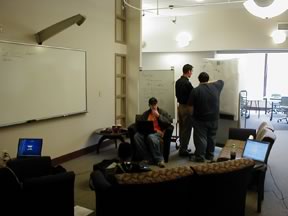
"Hi, Marcy," said the professor, then turned and saw Sara. "Hey, girl! You're going to be an English major. What are you doing with us history geeks?" George shuffled up to join them. His disheveled hair seemed a natural extension of his odd mixture of clothes. He also wore a perpetual look of bewilderment that successfully masked his quick mind. "Well, the philosophy guru has arrived," said Sara. George bowed graciously. "Morning, ladies." They then pulled up some of the rolling soft seats and chatted about what the first day might hold.
Later that week Marcy was in her residence hall living area with her roommates sharing war stories about their first adventures in college life.
"How did your day go, Tom?" He was not in the Core program but enrolled in the typical humanities program that held classes throughout campus. Tom frowned and shrugged. "It was, like, forever. Had history, English, and psych all the same day. That's 150 minutes of just sitting and listening to people talk at you. We did get to discuss things for a bit, but I mean, like, over two hours of just sitting in a chair!"
"Sounds like high school, man," chimed in Bruce. As others wandered in, Marcy mulled this over and thought of her day. She actually had gone early to study. Since her Core companions seemed to have a similar idea and also arrived a bit early, she met with her group. After a quick glance at her watch, she hurried downstairs and got a latté from the café, thus beginning her day. She, like Tom, had English, philosophy, and smatterings of history. She also had a bit of art and literature mixed in that day. But, she thought, this was apparently different from other students. How? she wondered. She found out over the next few weeks—and the difference was remarkable.
A few weeks later Marcy felt at home with her fellow students, her professors, and especially the place. The students had quickly assumed ownership of the space. They policed each other and felt free to move furniture and arrange the area as it best served the immediate purpose. There were no squabbles about who was responsible for what. Marcy and her friends—and she found that she included many of the faculty as friends—were not only learning, they actually enjoyed each day.
Professors Donna Gray and Renaldo Garcia were in the studios quite early, reminiscing. A year ago, during the first few days of trying out the new learning space, they had pondered a bit and then had come up with an idea. "Let's just switch rooms!" they had exclaimed at the same time. They would never have been able to do this in a conventionally scheduled array of classrooms. Donna needed Studio 117 that day as it had four plasma screens, one on each wall. Ron's class was going to do some research on the Web and then compare findings on the whiteboards (see Figure 3). Since then, changing rooms had become part of their daily routine, as it had for many other faculty. Now they freely traded spaces and often teamed up by having impromptu classes together.
Figure 3. Whiteboards in a Studio Setting
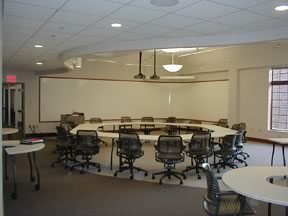
Today Donna made a quick switch with Ron, walked into Studio 117, now dubbed "The Sports Bar" by students with too much time on their hands. She punched in her password, detached the wall-mounted remote control, and put in her CD. She then fired up the electronics and smiled. "What till they get a load of this!" she thought.
That day was memorable to Marcy and her companions—and was becoming typical. She was encouraged to think, explore, create. It began as other days; get up early and get a latté from the café. She would worry about her diet later, she thought. She then went to the learning space, as she found it a quiet place to organize her day. "Am I actually forming good habits?" she wondered. She smiled. If so, she hoped the latté would neutralize it. Her friends slowly trickled in; by 7:30 a.m. most of her group had arrived. Funny, she mused, the other students, those attending "real" classes in typical classrooms across campus, didn't seem to arrive early. She shrugged and greeted her friends—or her community of learners, as her professors called them. Intriguing, she thought, that her professors also stressed that they were part of this community. Are they still learning also?
Today was a bit different. She started with Dr. Gray's lecture on Islam and Mohammed. The professor normally didn't lecture, but today she had prepared a series of photos, film clips, and cuts to Web sites that sprang up on the plasma screens. The 24 students sat in a circle, swiveling around as the scenes rotated with action (see Figure 4). Within 20 minutes they had been through a condensed history of Islam, its fundamental beliefs, and its prophets. The presentation also incorporated cuts from CNN, the History Channel, and various newspapers. The surround sound heightened the effect. Even though Professor Gray occasionally said "whoops" and corrected small glitches, the overall effect was powerful. The professor then further softened the lighting and asked the students to reflect quietly on what they had just experienced.
Figure 4. Plasma Screens in a Studio Setting
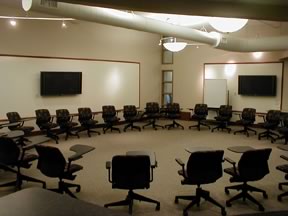
During this time a presentation in the adjoining studio focused on the history of Christianity. Professor Garcia used twin projectors simultaneously and occasionally highlighted the talk with points written on the large, writable wall surface. The sun crept in through the window, muted by the shades, and fell across the tabletops. The low up-lighting in the room provided a rich environment to experience some 2,000 years of history. The professor then called his students to reflect on the presentation.
In the Commons, a multiuse space at the far end, visiting sociology professor Cindy Metzger was speaking with the third Core cohort about Buddhism. After her presentation, strengthened by visual images, she had her group sit and try to meditate.
Twenty minutes later the entire learning space had become a hub of intense activity. Each of the cohorts of about 25 had dispersed in groups of four or five to prepare for an afternoon debate on the topic "Does religion or spirituality bring peace to the world—or the opposite?" Some of the students elected to stay in the studios and use the resources there: wall and portable marker boards, projection equipment, and access to the Web. A few groups snuggled into the table booths within a secluded area. Some pulled the flexible seating together and used both laptops and portable marker boards. (See Figure 5.) Coffee runs were frequent, and an occasional pizza materialized. At 2:00 p.m. the professors called a 10-minute break while the Commons was rearranged to hold the "Great and Profound, Earthshaking Event," as someone had scrawled on one of the marker boards. Three of the students had disappeared into their rooms and returned wearing improvised robes to further enhance the general ambiance. The rest of the day the student presentations were imaginative, provocative, and at times a bit silly. Some had brought in compelling information from various digital resources. The student presentations used the available technology. There were no winners—just a great amount of learning.
Figure 5. Class Collaboration in a Common Area
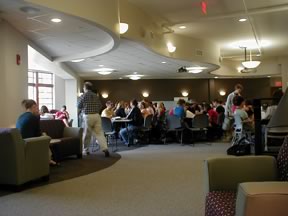
That evening after dinner, the students—and the faculty—were exhausted. Nonetheless, they returned to the Commons at 7:00 p.m. to attend a guest lecture. The topic, by mere coincidence, was "Religion: a path for world peace—or otherwise."
Two days later Marcy was pondering some of the issues brought up by the debate and other recent discussions. "I just don't get this one point," she thought. "It's got to be the foundation for what Dr. Garcia was explaining about the Gnostic philosophy, so I'd better get it. This concept seems to be extended even into our current times." She then remembered the information her group had pulled up on the Internet. They had accessed the Web during a break as they huddled together in the pathway. "Cool!" George had exclaimed as he tapped into a science fiction film site. Marcy had gotten up and crossed over to the faculty offices a few feet away. Ron Garcia had been talking with one of his colleagues.
"Pardon me, professor, but could you…?" Moments later Marcy, Professor Garcia, and Dr. Schramm were sitting in the alcove sofas and drew a crowd. Forty-five minutes later Marcy understood the concept and also had some new horizons opened about the connections between early church history and contemporary philosophy. More connections were made the next evening as they sat in the Commons to watch an obscure but important movie by a Mexican filmmaker from the 1960s. "Why was Mexico so antireligion for a while?" Marcy wondered. This led to her exploring the topic on her own. This, in turn, brought a developing interest in Latin American history and culture. She eventually ended up taking a minor in Spanish to go with her marketing degree.
Toward the end of the semester Marcy stretched and shuffled down the hall to start her day in the learning space. She nodded to some of her friends going off to what she now considered to be drudgery courses in history, English, and other subjects given at traditional areas of the campus. Stopping at the entry, latté in hand, she looked again at the inviting area filled with the soft sounds of conversation. She smiled and thought, "I'm sure glad I don't have to go to class today."
The Learner-Centered Difference
The story of Marcy and her companions, although fictional, is based on reports, observations, and assessments under way at the Marianist Hall Learning Space at the University of Dayton. Many of the observations correlate with the writings of teaching and learning scholars. We are just beginning to understand how important physical space is to learning and how radically different true learning-centered campuses will look in the future. The question is, just how will they be different?
In the story, Marcy, her friends, and the faculty used the space in new and different ways to achieve student success. George Kuh et al. contended that the two most important influences on student learning are interacting with faculty, staff, and peers in educationally purposeful ways and having a high degree of effort directed toward academic tasks.1 Vincent Tinto stressed the importance of learning extending beyond the classroom into corridors and walkways.2 Tinto and others contended that students are more likely to succeed in settings that assess skills, monitor progress, and provide feedback. Numerous educators stress the importance of students' social involvement and the social context of learning. Faculty are encouraged to become more engaged because they "influence the quality of students' experiences through their interaction inside and outside the classroom."3 Marcy and her colleagues experienced these teaching and learning opportunities more frequently and far more productively than would have occurred within the traditional credit-hour course offerings held in traditional classrooms.
The key, therefore, is to provide a physical space that supports multidisciplinary, team-taught, highly interactive learning unbound by traditional time constraints within a social setting that engages students and faculty and enables rich learning experiences. This space will be far different from the traditional classroom, and, while many significant designs contain parts of the solution, few examples of the envisioned pedagogical model exist. To provide the proper space for teaching and learning, we need more than a single place—educational activities are organic; they ebb and flow. (See Figure 6.) What we really require is a complex of spaces—interconnected and related spaces designed to support learning. These spaces will be flexible and functional and pay greater attention to aesthetics than traditional 20th-century classrooms. This design concept extends beyond the places normally designated as "academic" such that the entire campus can become a learning space. These principles guided the design of the Marianist Hall Learning Space at the University of Dayton.
Figure 6. Flexible Teaching and Learning Opportunities
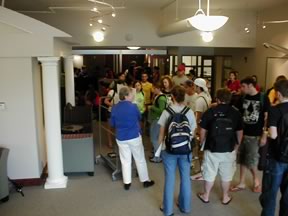
We are still in the embryonic stages of exploring design concepts that will ultimately shape the campuses of the future. While there are no real experts yet, many dedicated people are exploring ways to continually improve teaching and learning, assisted by talented and creative architects and planners in the design of spaces that support their visions. Students continuously challenge and motivate institutions' focus on learning excellence. The transformation of learning spaces holds immense challenges and presents opportunities not yet imagined. Our understanding of how students learn will continue to evolve, and the design of space will, at times, struggle to keep up. At other times, creative space will lead and challenge its users to break free of traditional restraints. We may never find the ideal learning space; the adventure is in trying to get there.
Endnotes
- George D. Kuh et al., Student Success in College: Creating Conditions That Matter (San Francisco: Jossey-Bass, 2005).
- Vincent Tinto, "Taking Student Learning Seriously: Rethinking the University of the Future," in Charting the Course: Earl V. Pullias Lecture Series on the Future of Higher Education, 26th Annual, Fall 2003 (Los Angeles: Center for Higher Education Policy Analysis, USC Rossier School of Education), <http://www.usc.edu/dept/chepa/documents/pullias/2003PulliasBooklet.pdf>.
- George Kuh, "Improving the College Experience: Using Effective Educational Practice," NSSE Viewpoint (November 2001), <http://nsse.iub.edu/pdf/viewpoint.pdf>.
About the Author
William Dittoe is a member in Educational Facilities Consultants, LLC, a firm specializing in planning built environments that support the mission of learning-centered institutions. Dittoe has been involved with the design of educational spaces for more than 40 years, with expertise in campus planning, classrooms, residence halls, and recreational and sports centers. For the past 10 years he has assisted learning-centered institutions in the design of learning environment prototypes. He regularly conducts institutional workshops and has given numerous presentations at regional and national conferences. His topics include the fundamental shifts in student expectations, campus culture, and pedagogy and their significant impact on facilities.